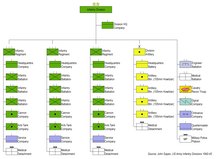A square division is a designation given to the way military divisions are organized. In a square organization, the division's main body is composed of four "maneuver," i.e., infantry regimental elements. Other types of regiments, such as artillery, are not "maneuver" units and thus are not considered in the "square," viz, "four" (infantry) regiments scheme.
The usual internal organization within a square division would be two brigades, each comprising two infantry regiments (consisting of two or three battalions.) Hence, on an organizational chart, the two infantry brigade, each with two infantry regiments would resemble a square. However, such divisions typically also include additional, supporting units such as artillery regiments.
By contrast, a triangular division generally has its infantry units organized in a "three by three" format. Historically, this has usually meant three regiments comprising three infantry battalions, with the three regiments either controlled by a single brigade or directly by the divisional headquarters. (In many armies, more recently, the infantry regiment, as a combat formation, has been abolished and triangular divisions are made up of three brigades, each consisting of three battalions.)
In most European armies, divisions were organized as square divisions prior to World War I. They were generally reorganized as triangular divisions during that war. Triangular divisions were smaller, allowing for more divisions to be formed, and were considered more suited for the positional warfare which characterized World War I. (See, for example, the organizational changes within the German Empire's 1st Division.)
A square division typically operates with either: two infantry brigades in line, and one infantry regiment forward and one in reserve, or; on a narrower front, with the brigades echeloned (one ahead of the other), (In contrast, the triangular division normally employs a "two up, one back" arrangement for its three infantry regiments/brigades.) In positional warfare, infantry regiments are formed in line to cover as much of a sector as possible, and are positioned with two battalions forward and one battalion behind, to provide defense in depth. An infantry regimental commander typically holds a reinforced rifle company or two (and rarely an entire battalion) from one of his three infantry battalions, with supporting arms, in the rear as a regimental reserve.

